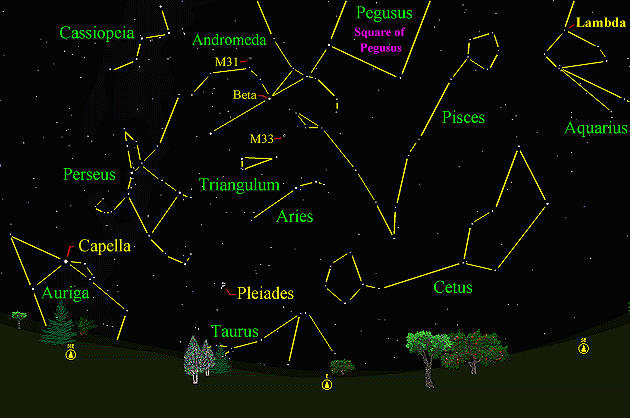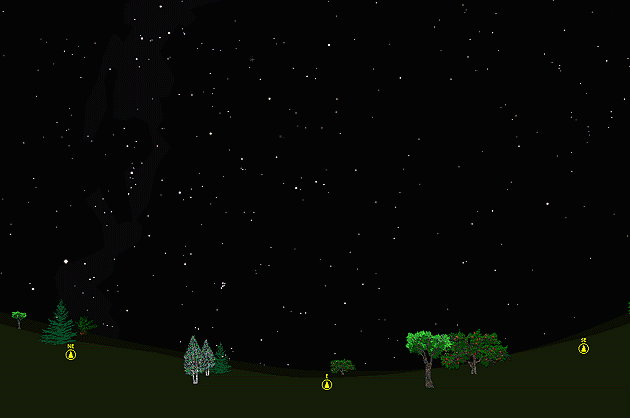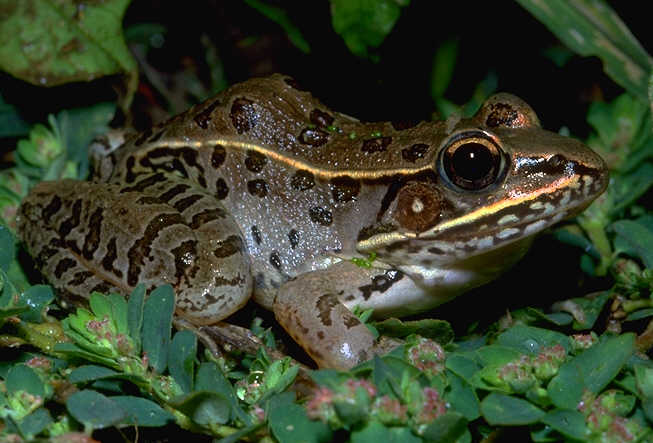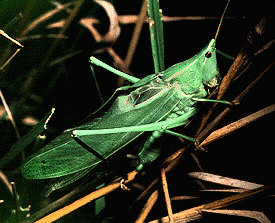The purpose of this feature is to give scout leaders, educators and naturalists an idea of some of the natural events coming up each month. We will try to cover a variety of natural events ranging from sky events to calling periods of amphibians, bird and mammal watching tips, prominent wildflowers and anything else that comes to mind. We will also note prominent constellations appearing over the eastern horizon at mid-evening each month for our area for those who would like to learn the constellations. If you have suggestions for other types of natural information you would like to see added to this calendar, let us know! Note: You can click on the hyperlinks to learn more about some of the featured items. To return to the Calendar, hit the "back" button on your browser, NOT the "back" button on the web page. All charts are available in a "printer friendly" mode, with black stars on a white background. Left clicking on each chart will take you to a printable black and white image. Notes and Images From September 2007
As I made my way through the beaver-created wetland, the air was filled with the sounds of Ruby-throated Hummingbirds. Spotted Jewelweed covered the entire area, and the hummers zipped from flower to flower. I could only count six or so at one time, but I suspect there were double that number there. Spotted Jewelweed has an interesting way of dispersing its seeds. If you touch a ripe fruit pod (lower image, left side) the pod splits along the longitudinal seams. The long strips that make up the outside of the pod then suddenly contract into small coils, stripping the seeds from the inner portion of the pod as they contract and dispersing the seeds in all directions. This reaction to disturbance gives this family of plants another name, the "touch-me-nots." The name, "Jewelweed" comes from the jewel-like silvery appearance of the leaves when submerged in water. This beautiful wildflower is found in wet areas throughout Tennessee in the fall. It is said that juice from the crushed leaves and stems of this plant helps relieve the irritation from reactions to poison ivy and stinging nettle.
Sky Events for October 2007: Bright Comet in Perseus! On Wednesday, October 24th, Comet Holmes brightened by a factor of approximately one million. To the naked eye, the comet looks like a bright star. It can be seen quite easily in the northeastern sky in Perseus just below the brightest stars of the constellation. In binoculars, it is an obvious fuzzy sphere, with no tail. You can use the finder charts in the link below, or simply look above the bright star Capella in the northeastern sky around 10:00pm. For more information go to: http://www.skyandtelescope.com/community/skyblog/observingblog/10775326.html
The Orionid Meteor Shower peaks in the morning hours of October 21st, with typical hourly rates of 10-15 meteors per hour in dark skies. Evening Sky: Look for bright Jupiter in the southwest at dusk, in Ophiuchus. At the beginning of the month it is about 6-1/2 degrees above the bright star Antares in Scorpius. Mars glows like a hot coal as it approaches opposition in December, rising around 10:25pm CDT in Taurus at midmonth. Morning Sky: Venus rises about 3:30am CDT at the beginning of the month. On October 7th, it forms a pretty grouping with Saturn, the bright star Regulus in Leo, and the waning crescent moon. By the 13th the two planets rise side by side about three degrees apart and five degrees below Regulus. All times noted in the Sky Events are for Franklin, Tennessee and are Central Daylight Time. These times should be pretty close anywhere in the mid-state area. Constellations: The views below show the sky looking east at 9:00pm CDT on October 15th. The first view shows the sky with the constellation outlined and names depicted. Star and planet names are in yellow. Constellation names are in green. The second view shows the same scene without labels. Prominent are Cassiopeia, Queen Cassiopeia, Andromeda, Princess Andromeda, Perseus, Triangulum, the Triangle, Aries, the Ram, and Cetus, the Sea Monster. Look above beta Andromedae and see if you can pick out the faint glow of the M31, The Andromeda Galaxy. City dwellers may need binoculars to pick it out. To get the best view, wait until the square is high overhead to look. If you find the Andromeda Galaxy, you might want to try to see M33, another nearby galaxy in Triangulum. Auriga, the Charioteer, with its bright star Capella, and Taurus, the Bull, are rising in the northeast. Look for the Pleiades, a beautiful open star cluster, not far above the eastern horizon. Also called the "Seven Sisters," this cluster has been known since antiquity. In Japan it is known as Subaru, and the Subaru automobile is named for this cluster.
On Learning the Constellations: We advise learning a few constellations each month, and then following them through the seasons. Once you associate a particular constellation coming over the eastern horizon at a certain time of year, you may start thinking about it like an old friend, looking forward to its arrival each season. The stars in the evening scene above, for instance, will always be in the same place relative to the horizon at the same time and date each October. Of course, the planets do move slowly through the constellations, but with practice you will learn to identify them from their appearance. In particular, learn the brightest stars for they will guide you to the fainter stars. Once you can locate the more prominent constellations, you can "branch out" to other constellations around them. It may take you a little while to get a sense of scale, to translate what you see on the computer screen or what you see on the page of a book to what you see in the sky. Look for patterns, like the stars that make up Cassiopeia. The earth's rotation causes the constellations to
appear to move across the sky just as the sun and the moon appear to do.
If you go outside earlier than the time shown on the charts, the constellations
will be lower to the eastern horizon. If you observe later, they will
have climbed higher. As each season progresses, the earth's motion around the sun causes the constellations to appear a little farther towards the west each night for any given time of night. The westward motion of the constellations is equivalent to two hours per month.
A good book to learn the constellations is H. A. Rey's classic, The Stars, A New Way to See Them. Rey's depictions of the constellations and witty commentary are terrific. A good general reference book on astronomy is the Peterson Field Guide, A Field Guide to the Stars and Planets, by Pasachoff. My favorite books about astronomers are Richard Preston's First Light, and the wonderful Starlight Nights, by Leslie Peltier. A good beginners software program for learning the night sky is the Starry Night Beginner program. Visit the Starry Night web site at www.starrynight.com The program retails for around $30.00 and contains a wealth of information. The best compact star atlas that I know of for use at the telescope is Sky & Telescope's Pocket Sky Atlas, published by Sky Publishing Corporation. This beautifully crafted star atlas is a joy to look at and a joy to use. The best compact star atlas that I know of for use at the telescope is Sky & Telescope's Pocket Sky Atlas, published by Sky Publishing Corporation. This beautifully crafted star atlas is a joy to look at and a joy to use.
Amphibians:
The frog and toad choruses continue to diminish in October, but some frogs and toads are still calling. Listen for Spring Peepers to call from patches of woods in the fall. On cool October nights, Southern Leopard Frogs call and breed as the cooler temperatures mirror their early spring breeding period. Southeastern Chorus Frogs sometimes give a very dry, raspy version of their call in October. You can locate many of the frogs and toads that have been calling more frequently earlier in the year by driving the back roads slowly on rainy nights. This is a two person job. One person watches the road for amphibians and one person looks out for other vehicles.
Birds: Fall migration continues. Red-breasted Nuthatches seem to be plentiful in conifers the last couple of weeks. Try to get out and bird as often as you can. Recommended: Bird Finding in Tennessee, Michael Lee Bierly. A classic guide to finding birds in Tennessee. The Sibley Guide to Birds, David Allen Sibley The Sibley Guide to Birds of Eastern North America, David Allen Sibley A Field Guide to the Birds of Eastern and Central North America, 5th edition. 2002. Roger Tory Peterson and Virginia Marie Peterson. If it's been a while since you've picked up a Peterson bird guide, you may be pleasantly surprised by the large image scale of the drawings. Just the thing for those fall warblers! An inexpensive guide for beginners is the Golden Guide for Birds.
Insects:
The listening season for insects is winding down, but I have to recommend that you run, don't walk, to your nearest bookstore and pick up the newly published, "The Songs of Insects," by Lang Elliott and Wil Hershberger. Besides having incredible images and detailed range maps and sonograms, it includes a CD of insect songs. All of this for $19.95! The book is published by Houghton Mifflin.
Archives (Remember to use the back button on your browser, NOT the back button on the web page!) Natural Calendar September 2007 Natural Calendar February 2007 Natural Calendar December 2006 Natural Calendar November 2006 Natural Calendar September 2006 Natural Calendar February 2006
Natural Calendar
December 2005
Natural Calendar
November 2005
Natural Calendar
September 2005
Natural Calendar
February 2005
Natural Calendar
December 2004
Natural Calendar
November 2004
Natural Calendar
September 2004
Natural Calendar
February 2004
Natural Calendar
December 2003
Natural Calendar
November 2003
Natural Calendar
September 2003 Natural Calendar February 2003 Natural Calendar December 2002 Natural Calendar November 2002 Nature Notes Archives: Nature Notes was a page we published in 2001 and 2002 containing our observations about everything from the northern lights display of November 2001 to frog and salamander egg masses. Night scenes prepared with Starry Night Pro software All images and recordings © 2007 Leaps
|





